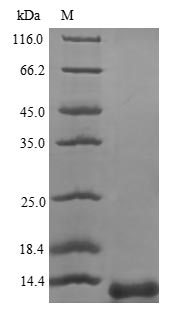The recombinant human PSAP protein is a fusion protein consists of the human PSAP protein (311-391aa) partnered with the N-terminal 6xHis tag. It was produced in the yeast. This recombinant PSAP protein's purity is greater than 90% determined by SDS-PAGE. After electrophoresis, there is a 12 kDa protein band presented on the gel.
Mutations in this gene have been associated with Gaucher disease and metachromatic leukodystrophy. Alternative splicing results in multiple transcript variants, at least one of which encodes an isoform that is proteolytically processed. Moreover, PSAP variants in Parkinson's disease have also been reported in a large cohort study in Chinese mainland population. PSAP encodes a prosaposin protein that degrades into four active saposins (A–D). Saposins A-D localize primarily to the lysosomal compartment where they facilitate the catabolism of glycosphingolipids with short oligosaccharide groups. It has been identified that prosaposin, as closely related with mTOR signaling, mediating inflammation in atherosclerosis. Additionally, PGRN binding to PSAP facilitated lysosomal trafficking of each other. The loss of lysosomal protein PSAP-mediated neuronal death OR or nonthermal plasma-activated Ringer's lactate-triggered ferroptosis.






